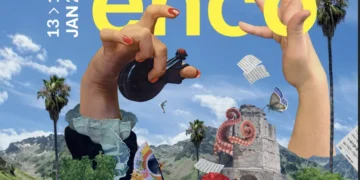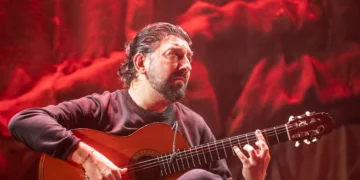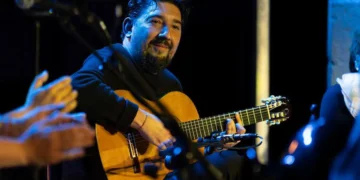|
FESTIVAL DE FLAMENCO DE NIMES
Diego Carrasco, Antonio Rey Tuesday, January 20th, 2009. 8:00pm. Odéon, Nimes (France) Festival de Nimes 2009 – All reviews |
|
Part one. Diego Carrasco, cante, dance, guitar. Ané, percussion Text: Estela Zatania Breaking the ice of an especially cold winter, once again the Festival de Nimes in the south of France brings all the warmth the best flamenco has to offer with a varied, high-quality program On Saturday the 17th and Monday the 19th, there had been preliminary shows with young hopefuls and French artists, and by Tuesday the 20th the people of Nimes were fully prepared to receive flamenco in one great gulp with the expansive, indescribable personality of Diego Carrasco. The charismatic man from Jerez who has been featured so many times in this festival, came with a minimalist format: his guitar, his voice, his son Ané on percussion and our mother compás who art in the flamenco heaven of Jerez, enveloping the city in an invisible sheltering force-field. Visually, not that different from the classic presentation of a singer and a guitarist that many flamenco fans are accustomed to. And yet, something else entirely. Because Diego Carrasco knows the rules of the game, and he pushes them to the absolute limits, always calculating diabolically well to abstract the essence without hurting the structure. For some, he goes too far. Others instinctively and immediately get the message, even in an audience of non-Spaniards.
More bulerías. Need it be said? Oneiric bulerías that see-saw between a sweet waltz time, and the aggressive mixed compás that broadcasts flamenconess. The liberation that comes through compás, lingua franca and hot-line to the crux, with a deceptively simple insinuated sway that takes no prisoners. We are escorted down the great flamenco highway by Diego Carrasco, even as a voice in our head protests “but he doesn’t do anything the way it’s supposed to be!” And the seducer continues to seduce. He devotes some words to Ramón de Algeciras who left our world that same morning, but not even that can stop the infinite fiesta inside Carrasco’s head, the fiesta he now delivers to us with a strange mix of bamberas, caña, La Tana y la Juana….”Carrasquerías”. ““On my passport they’re going to put ‘Diego Carrasco from Nimes de la Frontera’”, quips his flamenco highness, and he speaks of ‘gañanías’, those collective dwellings where so many people from Jerez scraped by years ago, and assuaged their suffering with a kind of flamenco now in danger of extinction. The same flamenco offered by this crusty old fox who plays the innocent. A distilled version of his popular song “Alfileres de Colores” decorated with the most elegant dancing to be seen in Jerez, and Carrasco glides off stage just as he came, without airs or pretence, with the serenity of great artists, leaving behind a deliriously happy audience. The second part was given over to young guitar maestro Antonio Rey. At 27, he has already passed through the back-up section of the best dance companies, he has won some of the most coveted prizes and he eats guitars with devastating ease. He begins alone (nowadays, guitar “soloists” often bring along a small army of musicians), with a sort of Levantine fantasy. Still alone with his instrument, he dedicates a soleá to Ramón de Algeciras. Rey is contemporary but reserved in his use of harmony. Tangos with bits of song, courtesy of his sister Mara Rey. Antonio then explains he is about to release a record, “A Través de Tí”, and violinist and percussionist join the group, as well as the guitarist’s father, singer Toni Rey. Mara Rey wraps things up just right with her bulerías song and dance, and we leave the café cantante with that warm glow of having lost track of time thanks to a high-quality flamenco evening. Festival de Nimes 2009 – All reviews
|
Descubre más desde Revista DeFlamenco.com
Suscríbete y recibe las últimas entradas en tu correo electrónico.





























